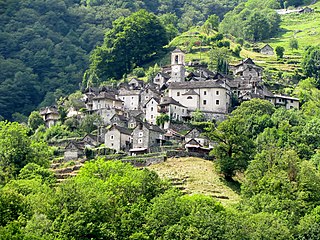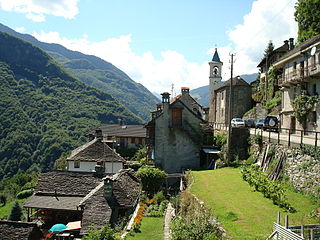
Locarno is a southern Swiss town and municipality in the district Locarno, located on the northern shore of Lake Maggiore at its northeastern tip in the canton of Ticino at the southern foot of the Swiss Alps. It has a population of about 16,000 (proper), and about 56,000 for the agglomeration of the same name including Ascona besides other municipalities.

Valle Maggia is an alpine valley in the Vallemaggia district of canton of Ticino, the Italian-speaking canton of Switzerland. The valley is formed by the river Maggia and is situated between the Centovalli and Lago Maggiore as well as the Valle Verzasca in the East.

Onsernone is a municipality in the Swiss canton of Ticino, near the city of Locarno. The river Isorno runs through this valley.

Cugnasco is a village in the municipality Cugnasco-Gerra of the district of Locarno in the canton of Ticino in Switzerland.

Corippo is a village and former municipality in the district of Locarno in the canton of Ticino in Switzerland.

Intragna is a village and locality in the municipality of Centovalli in the district of Locarno of the canton of Ticino in Switzerland.

Lavizzara is a municipality in the district of Vallemaggia in the canton of Ticino in Switzerland.

Borgnone is a hamlet part of the municipality of Centovalli in the district of Locarno in the canton of Ticino in Switzerland. Not to be confused with much bigger Camedo or with Lionza or Costa.

Mosogno is a former municipality in the district of Locarno in the canton of Ticino in Switzerland. On 10 April 2016 the former municipalities of Vergeletto, Gresso, Mosogno and Isorno merged into the municipality of Onsernone.

Gresso is a former municipality in the district of Locarno in the canton of Ticino in Switzerland. The municipality was formed in 1882 by splitting from Vergeletto. On 10 April 2016 the former municipalities of Vergeletto, Gresso, Mosogno and Isorno merged into the municipality of Onsernone.

Isorno is a former municipality in the district of Locarno in the canton of Ticino in Switzerland. On 10 April 2016 the former municipalities of Vergeletto, Gresso, Mosogno and Isorno merged into the municipality of Onsernone.
Gerra (Verzasca) is a part of the municipality of Cugnasco-Gerra in the district of Locarno in the canton of Ticino in Switzerland.
Loco is a village and former municipality in the canton of Ticino, Switzerland.

Russo is a village and former municipality in the district of Locarno in the canton of Ticino, Switzerland.

Crana is a village and former municipality in the district of Locarno in the canton of Ticino, Switzerland.

Centovalli is a valley and a municipality in the district of Locarno in the canton of Ticino in Switzerland. It is composed of 19 villages or hamlets "frazioni". The municipality was formed on 25 October 2009 through the merger of the municipalities of Borgnone, Intragna and Palagnedra.

Gambarogno is a municipality in the district of Locarno in the canton of Ticino in Switzerland. It was created on 25 April 2010 through the merger of the municipalities of Caviano, Contone, Gerra, Indemini, Magadino, Piazzogna, San Nazzaro, Sant'Abbondio and Vira.

Terre di Pedemonte is a municipality in the district of Locarno in the canton of Ticino in Switzerland. The municipalities of Cavigliano, Tegna and Verscio merged on 14 April 2013 into the new municipality of Terre di Pedemonte.

Verzasca is a municipality in the district of Locarno in the canton of Ticino in Switzerland.

Spruga is a village in the Swiss municipality of Onsernone, in the district of Locarno, in the canton of Ticino, Switzerland. It lies on the sunny, south-facing slopes above the Isorno river. Spruga is the last village on the sole road through the Onsernone Valley as well as the nearest settlement to the old thermal baths at Bagni di Craveggia where a 6-story hotel, now in ruins but open to the public, was built in 1819. In the 19th century, visitors to the baths had to take an 8-hour carriage ride from Locarno to Comologno and then walk the last three to four kilometers on a dirt trail through Spruga with their luggage on mules or carried by locals. Since the 1930's, when the old footpath to Comologno was upgraded to a road, Spruga has been tied into Switzerland's extensive public transit system by PostBus Switzerland which offers connections from morning until late evening as well as providing mail service. The large Post buses have become a key feature and tourist attraction of the region in their own right, as they traverse up and down the valley's narrow, winding road, honking their vintage-sounding horn to warn cars and pedestrians of their approach, often passing through villages with only centimeters of clearance from buildings on either side.


















